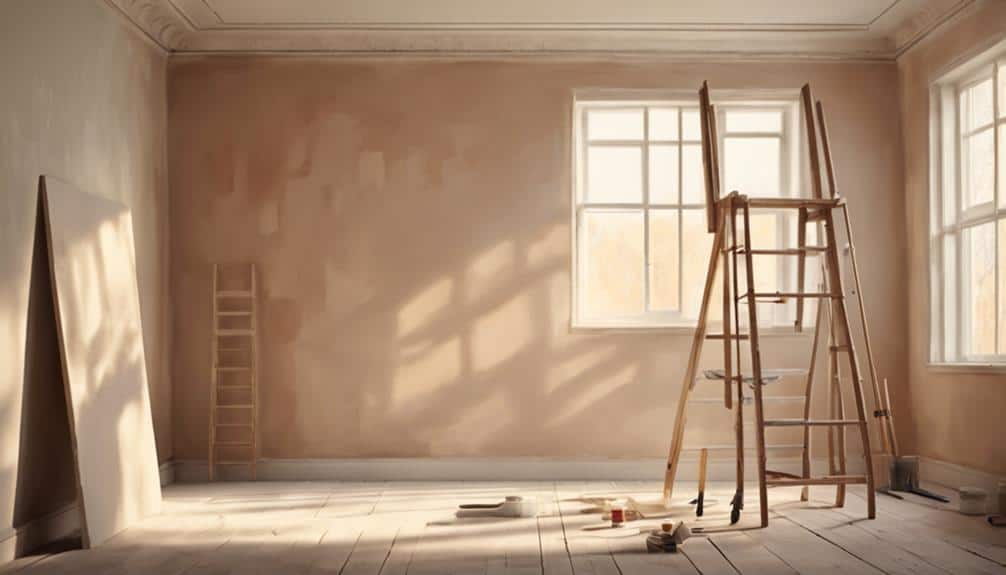You're wondering how long it'll take to paint a room. The answer depends on three key factors: the room's size, the condition of the walls, and the type of paint you're using. A larger room with imperfections on the walls and oil-based paint will take longer than a smaller room with smooth walls and fast-drying paint. Prep work, painting order, and your skill level also play a role. On average, a DIY project takes 4-8 hours, while a professional can finish in 2-5 hours. To get a more accurate estimate, consider these factors and the unique details of your project – and you'll be well on your way to a beautifully painted room.
Key Takeaways
• Room size significantly impacts painting time, with larger rooms requiring more time, and average bedrooms taking 4-6 hours to paint.
• Wall condition affects prep work and time, with imperfections requiring additional work and smooth walls resulting in faster painting.
• Type of paint used affects project duration, with water-based paints drying faster than oil-based paints and quick-drying paints speeding up the process.
• Proper preparation, including moving furniture and taping off areas, is essential to prevent issues and ensure an efficient painting process.
• Factors such as application methods, number of coats, and skill level also influence painting speed, making it crucial to consider these factors when estimating project time.
Room Size and Painting Time
The size of the room you're about to paint is a critical factor in determining how long the project will take. It's crucial to take into account the surface area that needs painting rather than just the room's overall dimensions.
Larger rooms, for instance, will naturally require more time to paint than smaller ones. Take an average bedroom, which is around 432 square feet, for example. It typically takes an average painter 4-6 hours to complete. This is because the surface area being painted is what truly matters, not just the room's size.
If you're only painting part of the room, like skipping the ceiling or a few walls, you'll reduce the time needed. So, don't just think about the room's size; think about the surface area that needs a fresh coat of paint. By doing so, you'll get a more accurate estimate of the painting time.
Condition of Walls Matters
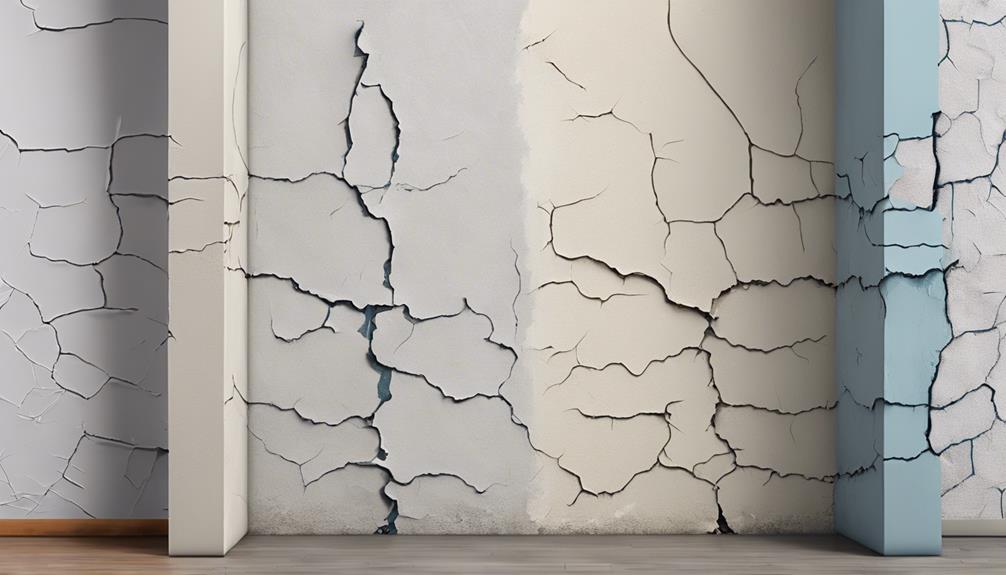
You'll greatly influence the duration of your painting project by considering the condition of your walls, as it's the surface quality that determines the amount of prep work and painting time needed. Walls with imperfections or damage will require additional prep work, such as filling in holes or sanding, which can extend the painting time.
On the other hand, smooth, well-prepared walls can result in a faster painting process, as the paint will adhere better and require fewer coats for a professional finish.
Assessing the condition of your walls before painting can help determine the extent of preparation needed and provide a more accurate estimate of the painting time. Investing time in wall preparation may seem tedious, but it can lead to a smoother and more efficient painting process, ultimately saving you time in the long run.
Type of Paint Used
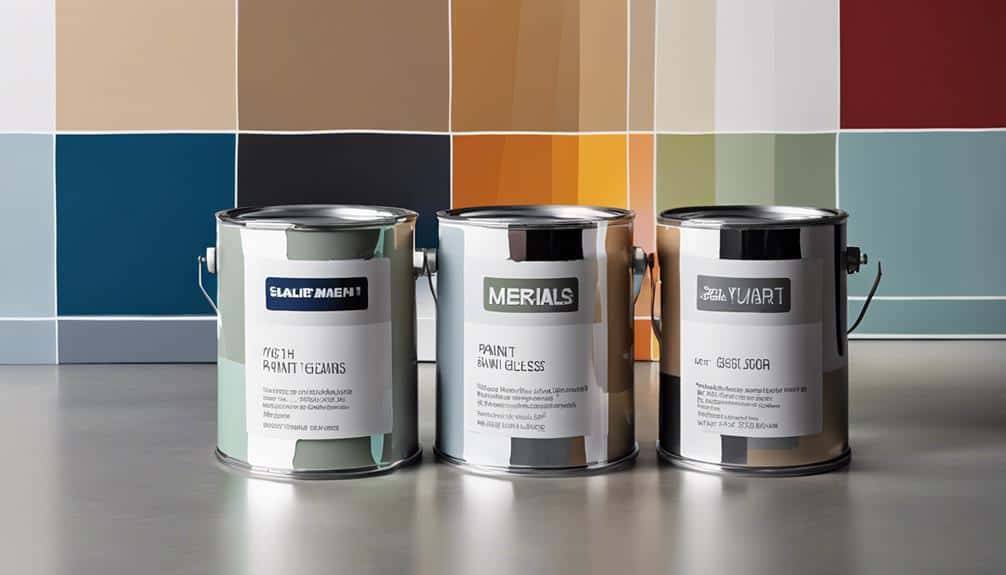
When it comes to painting a room, the type of paint you choose can greatly impact the overall duration of the project, and knowing the differences between various paint types can help you plan accordingly.
As you select your paint, consider the timeline you're working with. If you're on a tight schedule, water-based paints might be the way to go, as they typically dry faster than oil-based paints. Quick-drying paints can also speed up the process, allowing you to apply multiple coats in a shorter amount of time.
If you're looking for a hassle-free experience, specialty paints like one-coat coverage paints can significantly reduce painting time. Using fast-drying paint can also help reduce the wait time between coats, increasing efficiency.
Preparation Time Commitment

Before picking up a paintbrush, dedicate 30-60 minutes to proper preparation, an essential step that sets the stage for a successful painting project. This time commitment will pay off in the long run, ensuring a smooth and efficient painting process.
You'll want to move furniture away from walls, lay down drop cloths, and tape off areas you don't want to paint. This thorough preparation will prevent paint spills, splatters, and other unwanted issues during the painting process.
Neglecting this step can result in a messy or faulty paint job, so it's important to invest time in adequate preparation. By doing so, you'll create a clean and organized work environment that will save you time and frustration in the long run.
Painting Order and Strategy

To guarantee a smooth, efficient painting process, tackle the ceiling first, then move on to the walls, trim, and finally, doors and windows, following a logical order that prevents unnecessary delays and guarantees a professional-looking finish.
This painting order makes sense because any drips or spills from the ceiling will land on the walls or floor, which you'll be painting anyway. By following a strategic painting plan, you'll reduce time and effort in the long run.
Using the right tools, such as extension poles and quality brushes, can also speed up the process greatly. Additionally, opting for satin or gloss finishes for the final coat can expedite the overall painting time.
With the right tools and a well-planned painting order, you'll be able to complete your room painting project efficiently and effectively. By prioritizing your tasks and breaking them down into manageable chunks, you'll be able to tackle even the most challenging painting projects with confidence.
Drying Time and Recoating
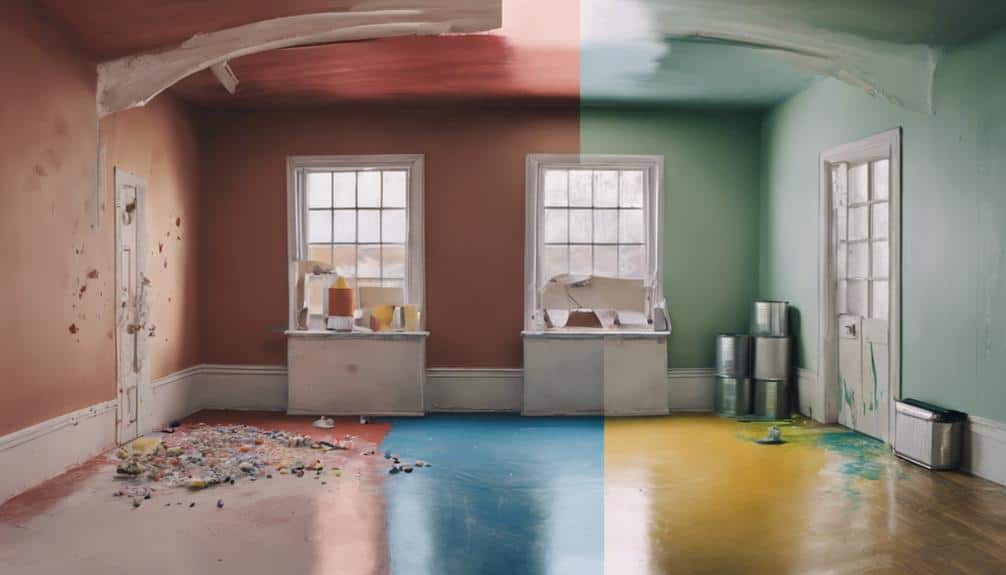
You'll need to factor in the drying time between coats to achieve a professional-looking finish, as rushing the process can lead to uneven color and paint streaks. Essential drying time is vital to prevent streaks and achieve a smooth finish.
Water-based paints typically take 2-4 hours to dry between coats, while oil-based paints may require 24 hours. Waiting for the paint to fully dry before recoating helps achieve vibrant color and covers imperfections.
Rushing between coats can lead to issues like uneven color and paint streaks. Following recommended drying times between coats is paramount for a professional and long-lasting paint job.
To avoid paint streaks, make sure to follow the recommended drying time for your specific paint type. Don't risk a subpar finish – take the time to let each coat dry properly before recoating. By doing so, you'll ensure a flawless, long-lasting paint job that you can be proud of.
Painting the Ceiling and Trims
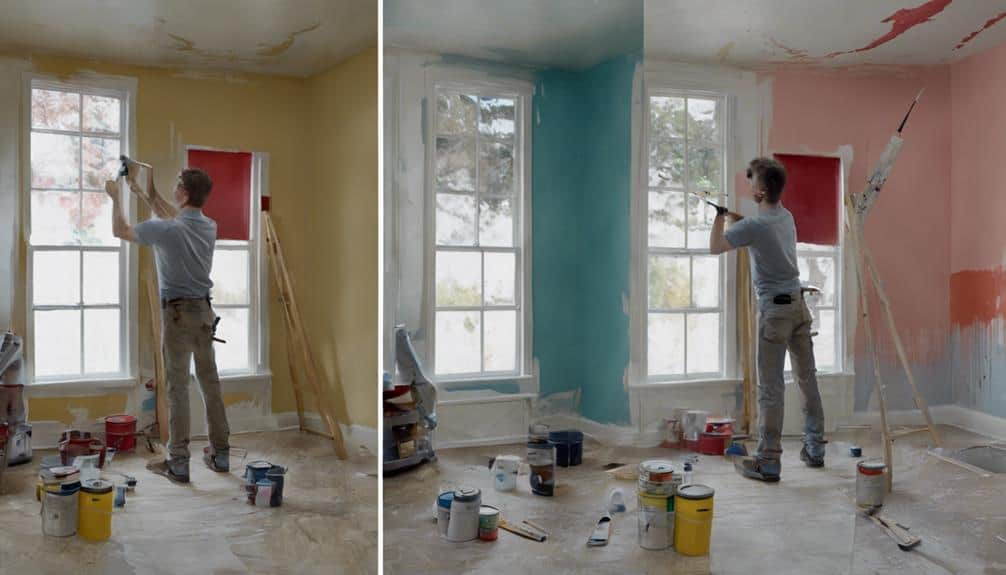
Painting the ceiling and trims is a crucial step in achieving a polished look, and it's important to factor in the additional time it requires. While it may seem like a minor detail, ceiling and trim painting can be time-consuming, especially if you're doing it for the first time.
Here are a few things to keep in mind:
- Ceiling painting typically takes 2-3 hours for an average-sized room, so plan accordingly.
- Trimming around doors, windows, and baseboards can add 1-2 hours per coat, so don't underestimate the time needed.
- Properly prepping and taping off areas before painting trims can save you time and ensure clean lines, making the process more efficient.
Additional Coats and Touch-ups

After applying the first coat of paint, you'll probably need to add extra coats to achieve the desired color and coverage, which can greatly extend the overall painting time.
Each additional coat requires 2-4 hours of drying time, so plan accordingly.
You'll also need to factor in time for touch-ups, which can take an additional 30 minutes to an hour to complete, depending on the extent of the work needed. Properly inspect the painted surface for inconsistencies and blemishes to determine the amount of touch-up work required.
Remember, touch-ups are vital for achieving a seamless and professional-looking paint job that meets your expectations. Investing time in thorough touch-ups can make a significant difference in the overall appearance and longevity of your painted room.
Don't rush this step, as it's essential for a flawless finish. By allowing sufficient time for additional coats and touch-ups, you'll guarantee a beautiful, long-lasting result that you'll be proud to show off.
Cleaning Up the Mess

Now that you've finished painting, it's time to tackle the cleanup.
You'll need to remove old paint, gather your supplies, and dispose of debris to get your space back in order.
Removing Old Paint
Before you can apply fresh coats of paint, you'll need to tackle the messy task of removing old paint, which can be a time-consuming process that requires patience and elbow grease. Removing old paint can take anywhere from 1-2 hours for a small area to a full day for larger surfaces.
To guarantee a smooth surface for new paint application, you'll need to scrape, sand, and dispose of debris properly. This process is vital, as any remaining old paint can affect the adhesion and appearance of your new paint job.
Here are some key considerations to keep in mind when removing old paint:
- Scraping and sanding are essential steps to remove old paint and create a smooth surface.
- Dispose of debris properly to avoid any hazards or mess.
- Consider hiring professional paint removal services for efficient and thorough removal of old paint.
Gathering Supplies
As you shift from removing old paint to preparing for a fresh coat, take about 30-60 minutes to gather all necessary supplies, ensuring a vital step will save you time and frustration in the long run. Start by collecting your paint, brushes, rollers, and drop cloths. Make sure they're in good condition and easily accessible.
Don't forget painter's tape and any other essentials specific to your project. Organize your workspace to maximize efficiency, keeping frequently used items within arm's reach. A clutter-free area will help you stay focused and avoid mistakes.
By taking the time to gather and prepare your supplies, you'll be able to immerse yourself into the painting process with confidence. A well-stocked workstation will minimize interruptions and keep your project on track.
Disposing Debris
With your freshly painted room transforming before your eyes, it's important to address the often-overlooked task of disposing debris to guarantee a neat finish and a safe workspace.
You've invested time and effort into painting, so don't let the mess linger. Dispose of debris properly to avoid accidents and maintain a clean environment.
Here are some essential steps to follow:
- Collect and dispose of paint cans, used brushes, and drop cloths responsibly. Check with your local authorities for guidelines on proper disposal and recycling options.
- Clean up spills and stains immediately to prevent them from setting in.
- Take the time to organize your workspace, putting away tools and materials to avoid clutter and tripping hazards.
DIY or Hiring Professionals
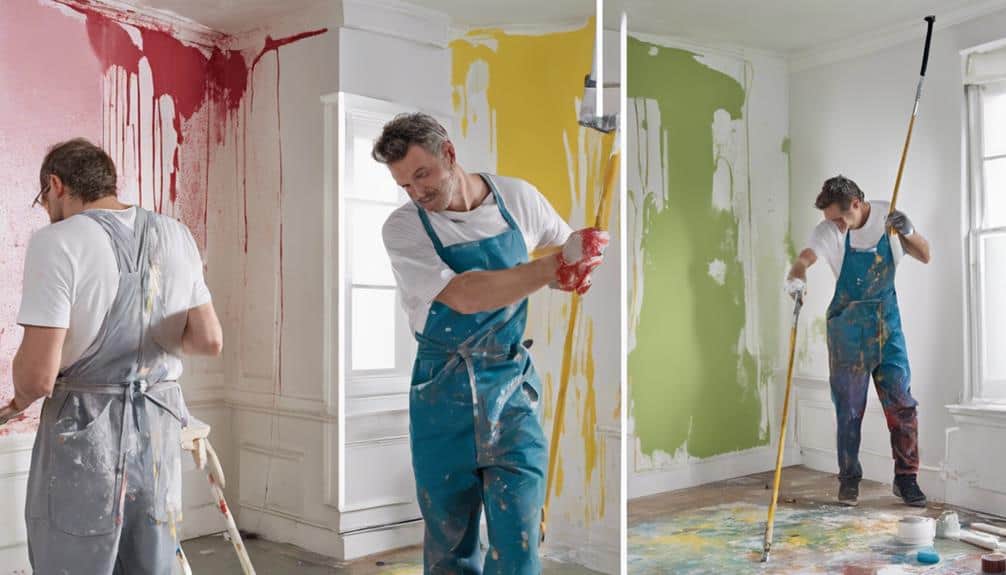
As you consider how to tackle your painting project, you're likely weighing the pros and cons of doing it yourself versus hiring a professional.
Your decision will greatly impact the overall time it takes to complete the job, as well as the quality of the final result.
DIY Time Commitment
You'll need to dedicate a significant block of time to DIY painting, which can take anywhere from 4-8 hours, depending on the size and complexity of the project. This time includes the actual painting time, as well as prep work such as moving furniture, taping, and repairing walls, which can add an additional 1-2 hours to the process.
When considering a DIY painting project, keep in mind the following:
- Time to apply: You'll need to factor in the time it takes to apply multiple coats of paint, allowing each coat to dry before applying the next.
- Prep work: Don't forget to account for the time it takes to move furniture, tape off trim, and repair any holes or cracks in the walls.
- Your skill level: Be honest about your painting skills – if you're a beginner, it may take longer to complete the project, and the quality of the finish may not be as high as you'd like.
Professional Painter Timeline
Hiring a professional painter can greatly reduce your painting time in half, freeing you up to focus on other important tasks. With their expertise, you'll save time and effort in the long run. A professional painter's efficient painting process guarantees a high-quality finish, and they can complete an average-sized room in just 2-5 hours, compared to 5-10 hours for a DIY project.
Their expertise shines in the prep work, where they'll efficiently handle tasks like taping, sanding, and cleaning. This attention to detail assures a smooth, even finish. By hiring a professional, you'll avoid the stress and physical demands of DIY painting, and still enjoy a beautifully painted room.
When deciding between DIY and hiring a pro, consider factors like room size, prep work, and painting method. If you value your time and want a flawless finish, hiring a professional painter is the way to go.
They'll take care of the entire process, from prep to cleanup, leaving you to focus on more important things. With their expertise and efficient painting process, you'll enjoy a beautifully painted room, minus the hassle and time commitment.
Factors Affecting Painting Speed

When you're preparing to paint a room, several factors can greatly impact the time it takes to complete the project. You might think it's just a matter of slapping on some paint, but the reality is that there are many variables at play.
Here are just a few of the key factors that can affect painting speed:
- Prep work and room size: The amount of prep work required, such as moving furniture and repairing walls, can add hours to your project. Similarly, the size of the room and area being painted will also impact the overall time needed to complete the project.
- Application methods and number of coats: The application methods you use, as well as the number of coats of paint you need to apply, can greatly impact the speed of painting.
- Skill level, tools, and helpers: Your skill level, the tools you have at your disposal, and whether you have any helpers can also affect the speed at which you can complete the project.
Frequently Asked Questions
How Long Does It Take to Paint a Room?
You're about to embark on a painting project and wonder, 'How long does it take to paint a room?'
Let's say you're tackling a 12×12 room with a simple layout. On average, it'll take you around 5 hours to complete the job, considering two coats of paint and some prep work.
However, this timeframe can vary depending on the room's size, the number of coats needed, and your level of expertise.
How Long Does It Take to Paint a Room in 3 Coats?
You're wondering how long it'll take to paint a room in 3 coats? Well, buckle up! On average, it'll take you around 8-12 hours, depending on the room's size and complexity.
This includes prep work, application, drying time, and clean-up.
Remember, each coat needs time to dry – 2-4 hours for water-based paint and 24 hours for oil-based paint.
Stay focused, and you'll be done in no time!
How Long Does It Take to Paint 4 Bedrooms?
Oh, you're wondering how long it'll take to paint 4 bedrooms? Well, buckle up, friend, because it's not a walk in the park! Seriously though, plan for around 16-24 hours of total painting time, assuming each room takes 4-6 hours to complete.
Don't forget to factor in prep work, ceiling height, and trim painting. But hey, with some planning and organization, you can streamline the process and get it done efficiently!
How Long Does It Take to Paint a 3 Story House?
You're wondering how long it takes to paint a 3-story house?
Well, the answer depends on several factors, including the size of the house, number of coats needed, and drying times.
On average, it can take several days to weeks to complete the project.
However, hiring professional painters can greatly reduce the timeline and guarantee a high-quality finish.
